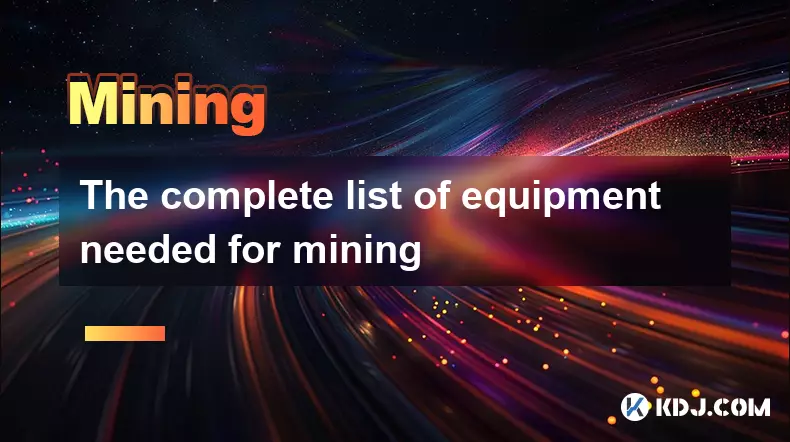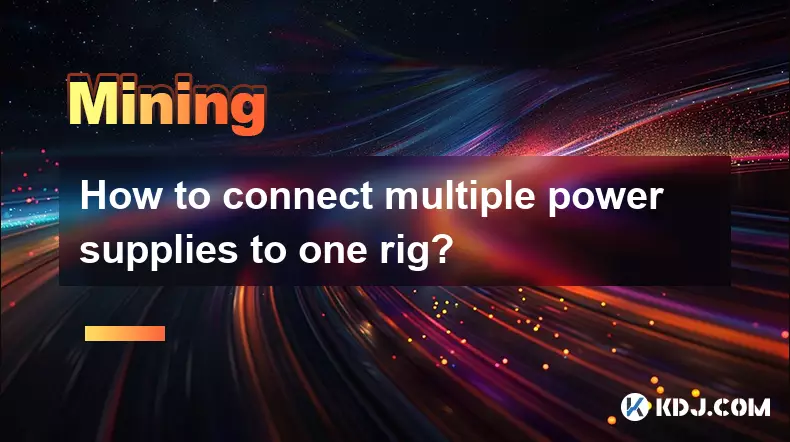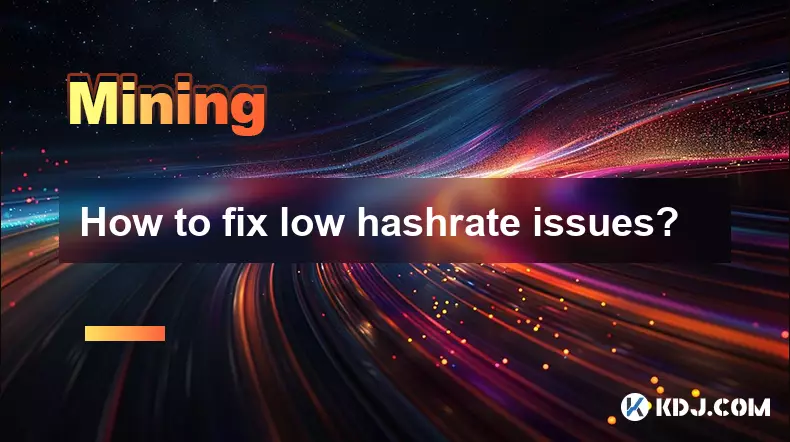-
 bitcoin
bitcoin $111145.080499 USD
0.75% -
 ethereum
ethereum $3928.989005 USD
1.66% -
 tether
tether $1.000226 USD
-0.02% -
 bnb
bnb $1108.209329 USD
-2.26% -
 xrp
xrp $2.545944 USD
6.36% -
 solana
solana $193.960655 USD
0.72% -
 usd-coin
usd-coin $1.000128 USD
0.02% -
 dogecoin
dogecoin $0.199304 USD
2.23% -
 tron
tron $0.297908 USD
-4.88% -
 cardano
cardano $0.656962 USD
2.13% -
 hyperliquid
hyperliquid $39.225782 USD
-1.92% -
 chainlink
chainlink $17.897108 USD
2.99% -
 ethena-usde
ethena-usde $0.999354 USD
-0.02% -
 stellar
stellar $0.321154 USD
3.36% -
 bitcoin-cash
bitcoin-cash $505.299839 USD
5.10%
The complete list of equipment needed for mining
A high-performance mining rig with GPUs or ASICs, reliable power supply, efficient cooling, and stable internet is essential for successful cryptocurrency mining.
Oct 20, 2025 at 05:55 am

Essential Hardware Components for Cryptocurrency Mining
1. A high-performance mining rig forms the foundation of any successful mining operation. These rigs are specifically designed to handle the intense computational demands of verifying blockchain transactions and solving complex cryptographic puzzles.
2. Graphics Processing Units (GPUs) or Application-Specific Integrated Circuit (ASIC) miners are the core components responsible for processing power. GPUs are versatile and support multiple cryptocurrencies like Ethereum, while ASICs are optimized for specific algorithms such as SHA-256 used in Bitcoin mining.
3. A reliable motherboard that supports multiple GPU configurations is necessary when building a multi-card mining setup. Motherboards with multiple PCIe slots allow connection of several graphics cards simultaneously.
4. A robust power supply unit (PSU) capable of delivering stable wattage across all connected devices ensures uninterrupted operations. Mining systems consume substantial electricity, so PSUs rated at 80 Plus Gold or higher efficiency are strongly recommended.
5. Sufficient RAM and a basic yet functional CPU help manage system tasks without bottlenecking the mining process. While the CPU does not contribute directly to hash rate, it plays a role in maintaining system stability.
Cooling and Ventilation Systems
1. Mining hardware generates significant heat due to continuous operation at high loads. Overheating can reduce efficiency and shorten equipment lifespan, making cooling a critical factor.
2. Industrial-grade fans or dedicated ventilation setups help maintain optimal ambient temperatures within mining facilities. Proper airflow prevents thermal throttling and protects sensitive electronic components.
3. Some miners install air conditioning units or use liquid cooling solutions, especially in large-scale mining farms located in warmer climates.
4. Enclosures with built-in exhaust systems direct hot air away from equipment and improve overall thermal management.
5. Monitoring tools that track internal temperatures allow operators to adjust fan speeds or shut down systems if thresholds are exceeded.
Networking and Connectivity Requirements
1. A stable internet connection is vital for synchronizing with the blockchain network and submitting proof-of-work solutions in a timely manner.
2. Ethernet cables provide more consistent and secure connections compared to Wi-Fi, minimizing latency and data loss during mining cycles.
3. Each mining device must be assigned a static IP address to simplify remote monitoring and troubleshooting across multiple nodes.
4. Routers with Quality of Service (QoS) settings prioritize mining traffic, ensuring minimal disruption during peak usage times.
5. Firewalls and security protocols protect mining operations from unauthorized access, DDoS attacks, and potential firmware exploits.
Software and Configuration Tools
1. Mining firmware such as HiveOS or SimpleMiner streamlines the deployment and management of large mining farms through centralized dashboards.
2. Wallet software compatible with the target cryptocurrency allows secure storage of mined coins. Wallets should support private key control and two-factor authentication.
3. Mining pool clients enable participation in collective hashing efforts, increasing the frequency of reward distribution based on contributed computational power.
4. Benchmarking utilities test performance under various load conditions, helping optimize clock speeds, voltage settings, and memory timings.
5. Remote access tools like SSH or VNC allow administrators to monitor rig status, update drivers, and restart unresponsive units without physical presence.
Frequently Asked Questions
What type of power supply is best for a GPU mining rig?A modular PSU with at least 750 watts per 6-GPU setup is ideal. Units certified with 80 Plus Gold or Platinum ratings deliver efficient power conversion and reduce long-term energy costs.
Can I use consumer-grade GPUs for professional mining operations?Yes, models like the NVIDIA RTX 3090 or AMD RX 6800 XT are commonly used in mining due to their high memory bandwidth and compute capabilities. However, durability under 24/7 workloads varies by manufacturer and cooling design.
Is it necessary to join a mining pool?Solo mining is possible but highly impractical for most individuals due to low probability of solving blocks independently. Mining pools combine resources and distribute rewards proportionally, offering more predictable income.
How do I protect my mining operation from hardware failure?Regular maintenance, dust filters, temperature monitoring, and redundant PSUs minimize downtime. Keeping spare parts like riser cables and motherboards on hand reduces repair delays.
Disclaimer:info@kdj.com
The information provided is not trading advice. kdj.com does not assume any responsibility for any investments made based on the information provided in this article. Cryptocurrencies are highly volatile and it is highly recommended that you invest with caution after thorough research!
If you believe that the content used on this website infringes your copyright, please contact us immediately (info@kdj.com) and we will delete it promptly.
- Essex Post Office, 5p Coins, and King Charles: A Royal Mint Revelation!
- 2025-10-23 10:30:16
- Waymo's Newark Airport AV Tests: Alphabet's AI Gamble Pays Off?
- 2025-10-23 10:30:16
- King Charles 5p Coins: A Royal Flush in Your Pocket?
- 2025-10-23 10:35:18
- Solana, Crypto Advisory, and Forward Industries: A New York Minute on the Future of Finance
- 2025-10-23 08:51:22
- MAGACOIN: Ethereum Whales Dive into the Hottest Presale of 2025
- 2025-10-23 08:51:22
- Kadena's End of the Road? KDA Token Plummets Amid Project Abandonment
- 2025-10-23 08:55:34
Related knowledge

How to use a VPN for crypto mining?
Oct 25,2025 at 06:01pm
Understanding the Role of a VPN in Crypto Mining1. A Virtual Private Network (VPN) creates an encrypted tunnel between your device and a remote server...

Is cloud mining a profitable investment?
Oct 25,2025 at 07:54pm
Understanding Cloud Mining in the Cryptocurrency Ecosystem1. Cloud mining allows individuals to participate in cryptocurrency mining without owning or...

How to connect multiple power supplies to one rig?
Oct 25,2025 at 10:36pm
Understanding Power Supply Configuration in Mining Rigs1. Connecting multiple power supplies to a single mining rig is common in cryptocurrency mining...

How to fix low hashrate issues?
Oct 25,2025 at 07:36pm
Understanding the Causes of Low Hashrate1. Outdated firmware on mining hardware can severely limit performance, leading to reduced hashrate across ASI...

A simple explanation of the Bitcoin mining process
Oct 21,2025 at 05:54am
What Is Bitcoin Mining?1. Bitcoin mining is the process by which new bitcoins are introduced into circulation and transactions are verified on the blo...

How to get started with Litecoin mining?
Oct 19,2025 at 07:01am
Understanding Litecoin Mining Basics1. Litecoin mining involves verifying transactions on the Litecoin blockchain using computational power. Miners so...

How to use a VPN for crypto mining?
Oct 25,2025 at 06:01pm
Understanding the Role of a VPN in Crypto Mining1. A Virtual Private Network (VPN) creates an encrypted tunnel between your device and a remote server...

Is cloud mining a profitable investment?
Oct 25,2025 at 07:54pm
Understanding Cloud Mining in the Cryptocurrency Ecosystem1. Cloud mining allows individuals to participate in cryptocurrency mining without owning or...

How to connect multiple power supplies to one rig?
Oct 25,2025 at 10:36pm
Understanding Power Supply Configuration in Mining Rigs1. Connecting multiple power supplies to a single mining rig is common in cryptocurrency mining...

How to fix low hashrate issues?
Oct 25,2025 at 07:36pm
Understanding the Causes of Low Hashrate1. Outdated firmware on mining hardware can severely limit performance, leading to reduced hashrate across ASI...

A simple explanation of the Bitcoin mining process
Oct 21,2025 at 05:54am
What Is Bitcoin Mining?1. Bitcoin mining is the process by which new bitcoins are introduced into circulation and transactions are verified on the blo...

How to get started with Litecoin mining?
Oct 19,2025 at 07:01am
Understanding Litecoin Mining Basics1. Litecoin mining involves verifying transactions on the Litecoin blockchain using computational power. Miners so...
See all articles










































































